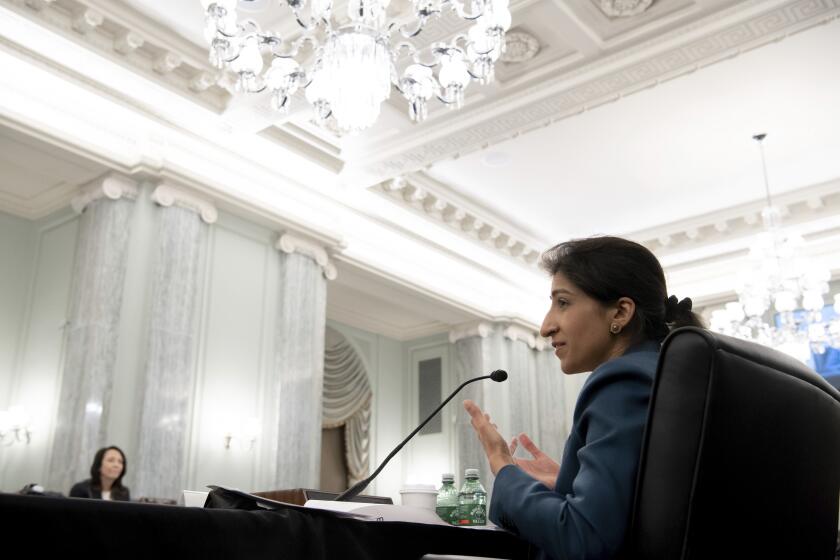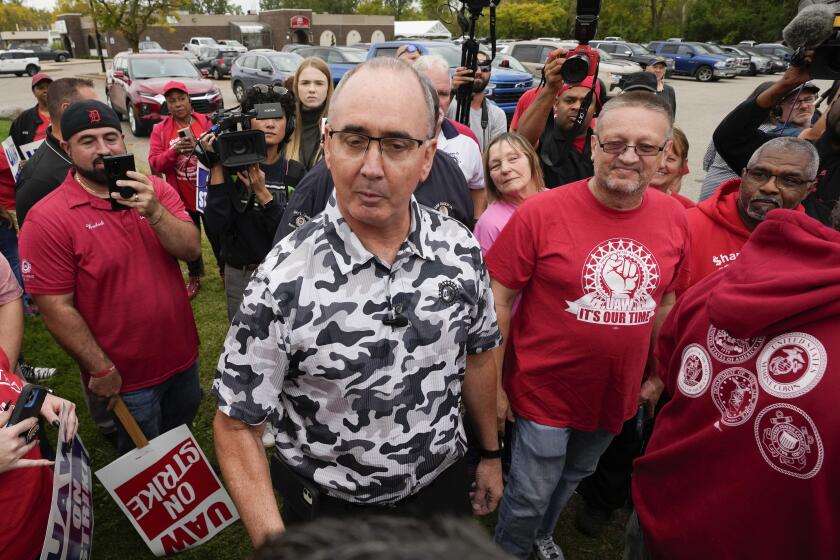Column: Trump’s proposal to make overtime pay tax-exempt obscures how awful he was for all workers

- Share via
Donald Trump, in his determined effort to claim the mantle of friend of the working man and woman, unveiled a proposal the other day to make overtime pay tax-exempt.
“People who work overtime are among the hardest-working citizens of our country, and for too long, no one in Washington has been looking out for them,” he told a rally in Tucson.
Let’s be blunt about something here: Anyone who buys Trump’s pose about this is the mark in a con game. Trump’s claim that no one in Washington has been looking out for overtime workers was never as true as it was during the Trump administration, which slashed overtime protections for more than 8.2 million workers.
Trump’s Department of Labor was a black hole for worker rights. The agency abandoned an Obama administration policy that would have favored more than 4.2 million workers. The Biden administration restored the Obama rule and went further.
And that was just on overtime. As president, observed economic commentator Pedro Nicolaci da Costa in 2019, Trump pursued “the most hostile anti-labor agenda of any modern president.”
Trump’s Dept. of Labor was a black hole for worker rights.
Before exploring Trump’s manipulation of overtime regulations, let’s examine his overall record on workers’ rights.
In 2019, Trump appointed as his Secretary of Labor Eugene Scalia, son of the late Supreme Court Justice Antonin Scalia. The new labor secretary had made his career as a corporate lawyer fighting pro-worker policies. In 2012, the Wall Street Journal had labeled him one of the financial industry’s “go-to guys for challenging financial regulations.”
Get the latest from Michael Hiltzik
Commentary on economics and more from a Pulitzer Prize winner.
You may occasionally receive promotional content from the Los Angeles Times.
Scalia had helped Walmart overturn a Maryland law mandating minimum contributions by big employers for workers’ healthcare, defended SeaWorld against workplace safety charges after a park trainer was killed by an orca (he lost that case), and had written extensively against a federal regulation expanding ergonomic safety requirements.
He had written that the latter rule, proposed by the Occupational Safety and Health Administration, “would require businesses to slow the pace of production, hire more workers, increase rest periods and redesign workstations or even entire operations.”
No legitimate candidate for secretary of Labor would have regarded that policy as a bad thing, but Scalia condemned it in print as “the most costly and intrusive regulation in [OSHA’s] history.”
The Federal Trade Commission banned non-compete clauses, which block workers from moving to better jobs. A Trump-appointed judge has blocked it--of course
Scalia’s predecessor as secretary, Alexander Acosta, had gone to Congress to oppose measures to raise the federal minimum wage, which has been stuck at $7.25 an hour since 2009 to $15 in steps. It shouldn’t need mentioning that this was an extraordinary position for a secretary of Labor to take.
(Acosta, it may be remembered, lost his job after revelations about his role in soft-pedaling sex-trafficking charges against Jeffrey Epstein produced a political uproar.)
Trump remade the National Labor Relations Board along the same lines. In a key move, his NLRB scrapped the effort under Obama to expand the definition of “joint employer,” which would have made big franchisers such as McDonald’s jointly liable with their franchisees for violations of employees’ wage and hour rights.
The Trump NLRB’s proposed definition would narrow the joint-employer standard “to the point at which many workers would find it nearly impossible to bring all firms with the power to influence their wages and working conditions to the bargaining table,” according to the labor-oriented Economic Policy Institute.
Put it all together, and Trump had turned the Department of Labor into the “Dept. of Employer Rights,” I wrote.
Now to the overtime rules. As my colleague James Rainey reported Sunday, Trump’s proposal to make overtime pay tax-exempt was part of a passel of purported tax cuts for the working class, including tax exemptions for tips and Social Security benefits, all of which economists saw as “gimmicks” and “shams.”
After decades of defeats in its drive to unionize Southern auto plants, the UAW scores a big win in Chattanooga. Other plants are now in its sights
In 2016, Obama had raised the ceiling making salaried workers eligible for time-and-a-half overtime — that is, working hours exceeding 40 hours per week — to $47,476 in annual wages, up from $23,660. The ceiling would be adjusted regularly to overall wage growth. Hourly workers typically get overtime after 40 hours, but salaried workers receive overtime pay if their wages are below the ceiling.
The Obama administration’s idea was to narrow the practice of low-wage employers to designate workers as “managers” to exempt them from the OT rule while paying them an hourly wage. (That’s why fast-food restaurants are always suspiciously loaded with “general managers, assistant managers, night managers, managers for opening and closing and delivery,” as former New York prosecutor Terri Gerstein observed in 2019.)
It was estimated that the new rule would give 4.2 million workers new overtime protection.
The Obama rule was blocked by a federal judge in Texas. When Trump came into office, his Labor Department refused to defend the rule in court. Instead, the agency proposed a new rule reducing the wage ceiling to only $35,568. That was nearly $20,000 below the level that would have been reached by the Obama rule, as it was adjusted for wage inflation. The Trump rule was not indexed.
Some 8.2 million workers who would have gained OT protection under Obama were left behind by the Trump rule, Heidi Shierholz of the pro-labor Economic Policy Institute calculated. They would be deprived of a combined $1.4 billion in pay annually.
The 8.2 million workers left behind, Shierholz estimated, included “4.2 million women, 3.0 million people of color, 4.7 million workers without a college degree, and 2.7 million parents of children under the age of 18.”
The Biden administration restored the Obama rule, and then some. The new rule set the ceiling at $844 per week, or $43,888 for a full-time hourly worker, as of July 1.
On Jan. 1, the salary ceiling will rise to $1,128 per week, or $58,656 annually. After that, it will be indexed every three years. The new rule will benefit an estimated 4.3 million workers, more than half of whom are women and about one-fifth workers of color.
The UAW’s great new contracts with GM, Stellantis and Ford show that union solidarity and concrete goals bring major victories for workers for the first time in decades.
Among the largest groups of affected workers, EPI estimates, are those in healthcare and social services.
Whether Trump has sat down to map out a pro-worker policy is doubtful in the extreme — it’s not a concern he has ever displayed in the past. He appears to have blurted out the overtime policy as part of what the Irish writer Fintan O’Toole aptly describes as “the surreal bricolage of his rally speeches.”
But a clue can be found in “Project 2025,” a road map for a second Trump term drafted by the right-wing Heritage Foundation. (Trump claims to have nothing to do with this 900-page tome, but no one really believes him.)
Project 2025 would shrink overtime coverage materially. It advocates cutting the compensation subject to time-and-a-half to salary only, excluding pay for such benefits as healthcare, retirement, education, child care or paid meals. Under existing law, the only compensation that can be excluded from the calculation is pay for expenses a worker pays on the employer’s behalf, discretionary bonuses, gifts on special occasions, and vacation and sick pay.
The Project also advocates indexing the ceiling once ever five years rather than three years, which would slow its rate of growth, and index the ceiling to consumer inflation, which tends to grow slower than wage inflation, the current index.
The Project also advocates allowing employers to calculate overtime hours over two or four weeks rather than weekly, which would allow them to require workers to put in more than 40 hours some weeks and make it up in others. That sounds like an open invitation to employer manipulation of work schedules.
Trump’s record on worker rights is clear as day. Do you really think he’ll be looking out for the men and women in the rank and file?
More to Read
Get the latest from Michael Hiltzik
Commentary on economics and more from a Pulitzer Prize winner.
You may occasionally receive promotional content from the Los Angeles Times.














